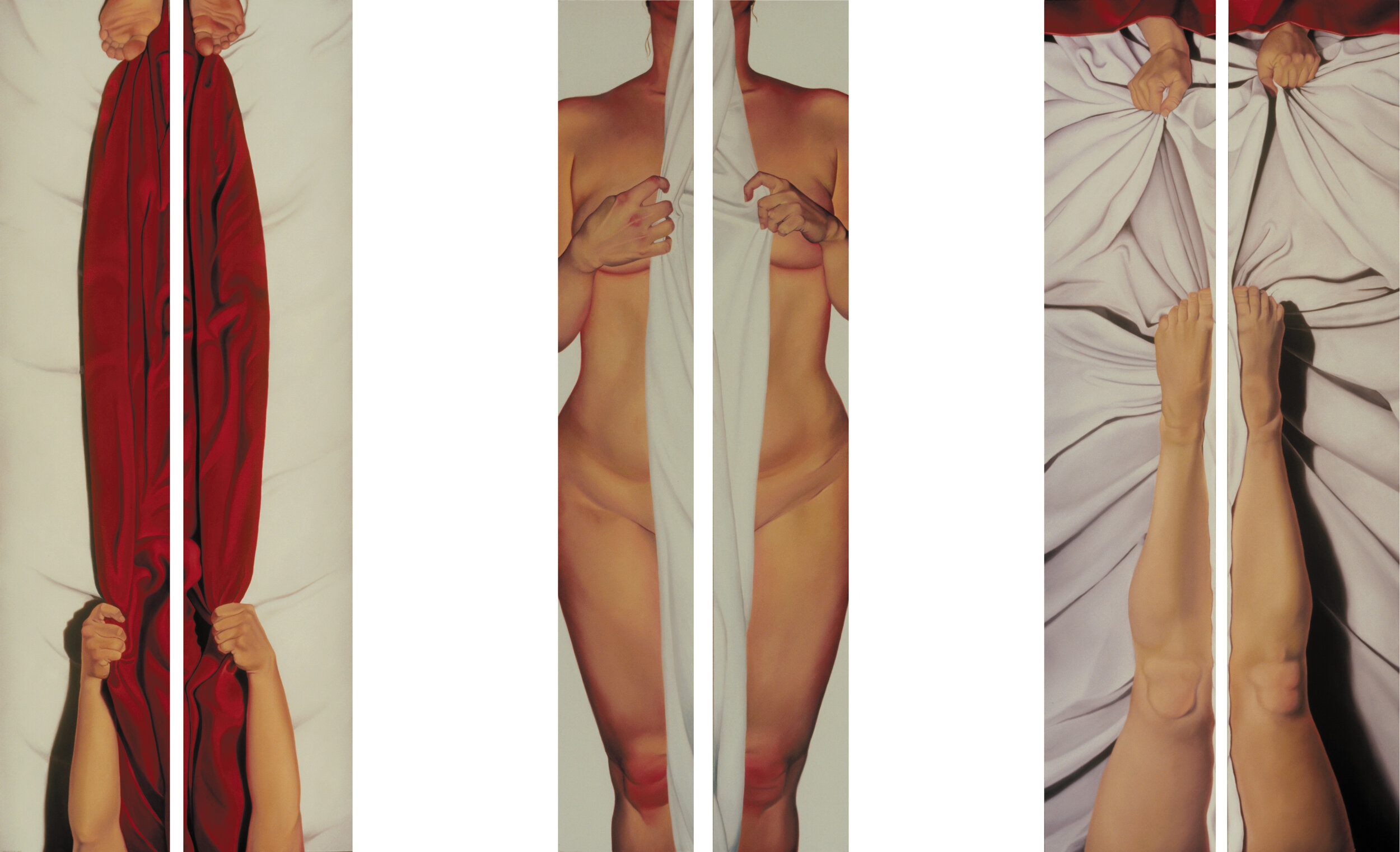First Person
The sickness linger / The wait is bearing down / But can't let go
oil on canvas, 84 x 19 / 62 x 37 / 84 x 19 inches, 2005
The need is cyclical / The surface fracture / The exhausting task
oil on canvas, 62 x 24 / 56 x 18 / 62 x 24 inches, 2005
From the Press Release
Like Pop Art and the new abstraction, with their problematic intellectual content, contemporary realism offers no simple solution of a nostalgic return to the figure or to an outlived classical humanism. It confronts the second-hand visual experiences and media sources in our culture with the same unsettling honesty, which is given to traditional examples of realism. So long as realism maintains such a refreshing candor, and keeps open a dialogue with problems of some contemporary urgency in regard to representation, it promises to remain a vital alternative during a period otherwise dominated by increasingly abstract and dematerialized expressions of the artistic spirit.
Since graduating from the Rocky Mountain School of Art and Design in 2003, Jenny Morgan’s career as a contemporary realist has not gone unrecognized. On the contrary, Morgan’s talent has skyrocketed near stratospheres otherwise reserved for the established elite. Her uprising as a painter has been a refreshing spectacle for Denver to behold , let alone those associated with her development. In her Plus Gallery debut "First Person, Future Tense" alongside master contemporary realist Peter Illig, Morgan is poised to deliver a compelling and fresh array of imagery that will further the way we view the nude figure.
"Soliloquies," the artist's last exhibition at Pirate, was filled with pure flesh. Morgan's intent was to literally strip the figure and let color and the simplicity of gestures speak for the content. The body of work was void of outside symbolism; the female form stood on its own to communicate solely with skin and backdrops filled with potent color. Radical cropping of the form was used to isolate specific pieces, emphasizing the meaning inherent in each pose.
"By using my own body, the work was an exploration in self-portraiture and translating the inner world of the self outwards." - J. Morgan
As the "First Person" of the exhibition, Morgan’s new work still rides the vein of self-portraiture, but she has chosen to employ fabric as a powerful, emotional symbol. Fabric has long been used in paintings for religious symbolism, generally through colorful garments that denote stations of power or social status. The artist reprises this ancient symbolic tool as a means to communicate emotion. As the fabric undulates around, under, above and between the figures, a compositional relationship is created. For Morgan, this beautiful relationship is an effort to communicate the extension of emotion on behalf of the female body.
Much of the content behind each piece is about communication and the obstacles that lie between the form and her personal expression. The fabric is a colorful pathway for the figure to relate strong sentiment. Communication for the figure is stalled and compromised by breaking the picture plane directly in half. The spectrum of color is also carefully considered. Morgan utilizes archetypal colors to aid in meanings; red denotes powerful pain and passion, white holds innocence and purity, black is heavy with death and the unknown, and yellow tends to abundance of light and joy.
"Through the self-portrait, I use the body as a vehicle for self-examination, but also a way to connect the human experience of one person to a wide audience. I hope to communicate my world in a way that the viewer can react and relate." - J. Morgan
Morgan's talents were revealed to Zeile when she served at age 20 as the gallery's first intern in February of 2003. It is not prototypical to have gallery interns that exhibit extreme strength in their artistic fields, but Morgan proved with her first unveiling at the RMCAD student show that she was not only a natural talent, but dedicated to her craft, and hugely ambitious with mature ideas that belied her age. The gallery found in her an emerging artist largely unparalleled in her artistic determination.
Recent years have produced variants of realism with combinations of sharply simplified, hard-edge abstractions and subject matter taken from photographic or photo-inspired sources. It is the simple factualism and flat insipid reality of the photographed image which provide the prototypes for this new, contemporary realism, rather than the traditional example of realistic painting. Both its intense fidelity to photographic or real-life models and an equally insistent formal structuring identify the new realism as an art pushed to extremes.

